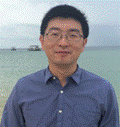报告题目:Lithium-Sulfur Batteries from the Perspectives of Organic-based Materials and Full Cell Design

报告人:王大伟 博士
报告时间:2017年12月15日10:00-11:00
地点:西安交通大学化工学院办公楼106
个人简介:
Da-Wei Wang joined UNSW in 2014, and is currently Senior Lecturer in School of Chemical Engineering. He was appointed as UNSW Scientia Fellow in November 2017. His research focuses on the chemistry and synthesis of high-performance energy materials, and the design of new generation renewable energy conversion/storage devices, including supercapacitors, metal/sulfur batteries, metal-ion batteries, aqueous redox flow batteries, and fuel cells. Part of his interest is dedicated to the exploration of novel two-dimensional materials and the new properties. As a Chief Investigator, Da-Wei has attracted external funding (>3M A$) from competitive government schemes and industrial partners. Da-Wei has contributed 2 book chapters, >100 journal publications, 8 patents and over 20 keynote/invited presentations, which received >13,000 citations with an H-index of 40 (Google Scholar). Da-Wei has won some prestigious awards including 2012 Fundamental Research Excellence Award of University of Queensland, 2013 Scopus Young Researcher Award in Engineering and Technology (Australian Universities).
报告内容介绍:
Li/S battery has recently been recognized as the new generation battery technology.Unfortunately,many challenging issues have slowed down its progress to commercialization. These obstacles essentially include, but are not limited to, the instability of the sulfur cathode and the dendritic interface of the lithium anode.
This talk will spread to the three selected aspects associated with Li/S cell: cathode materials, interlayer and full cell design.
Various sulfur-based composites with a secondary phase of carbons, polymers, oxides, sulfides or carbides have been developed as advanced cathode materials for Li/S batteries. We will introduce the synthesis and properties of solid-state organic polysulfides as alternative cathodes for Li/S batteries. The capping moieties in the organic polysulfides not only introduced redox activity, but also acted as polysulfide ‘fishing’ spots to mitigate the polysulfide leaking problem.
Aside from the cathode materials, the interlayerplays a critical role in regulating the ionic flux and maintaining a healthy cell condition for durable device performance. We will share the recent discovery of the electrochemical glassification of metal-organic frameworks in the presence of polysulfides, and interpret the operating mechanism of MOF interlayer from a different structure point of view.
Bringing all optimal battery components (electrode, electrolyte, separator, interlayer, etc.) to enable working full cell is the ‘Holy Grail’ of Li/S battery research. A strategy of parallel solid-liquid interface engineering will be introduced for the design of Li/S full cell. The improvement of sulfur utilization and the suppression of sulfur exhaust and dendrite growth were simultaneously achieved via modifying the composition and surface homogeneity of the anode and cathode of the full cell.


